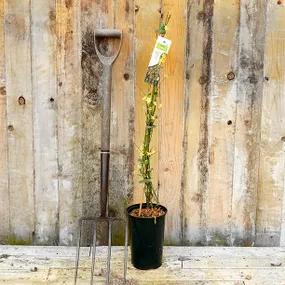Winter Flowering Jasmine Plants
Honest Delivery PricesJasminum nudiflorum
- Bright yellow flowers. No scent
- Deciduous
- Semi-trailing shrub with arching stems
- Easy to tie to a wall
- Looks best tumbling down
- Shade tolerant
- Grows to 8'
- Full hardy
- RHS Award of Garden Merit
Description
Jasmine 'Nudiflorum'
Winter Jasmine (Jasminum Nudiflorum) is a popular shrubby-climber that flowers in Winter, about December till March, on bare wood.
Well grown, it can be so covered in yellow blooms that the slim green stems are almost invisible.
The unscented flowers are followed by pinnate dark green leaves on delicate arching stems.
This plant is on the border between a lanky shrub and a climber: it needs the support of wires or trellis, with yearly tying in place, to properly climb.
Winter Jasmine looks best when used as a trailing plant, tumbling down from a higher to lower level.
We cannot lie: winter jasmine is a one-trick pony.
When it's not in flower, it's a fairly dull mass of twiggy green stems that always looks untidy, which fits informal garden styles but struggles to fit into a neat formal garden.
"Gardeners put up with this gawky, sprawling shrub for one reason and one reason only – its crop of yellow flowers borne at the dawn of the New Year. They are welcome and pleasing, yes, but the rest of the plant has about as much panache as a bundle of pick-up sticks."
- Dan Cooper, The Frustrated Gardener
Have a look at the rest of our range of jasmine plants
Great for your garden:
Jasmine prefers soil rich in organic matter that is just either side of neutral, moist and free-draining. It prefers sun or partial shade but it is fully hardy and easy to grow
Jasminum 'Nudiflorum' is the perfect climbing plant to brighten up a dull corner in winter. It can be used as a deciduous climber, with the support of vine eyes and wires or trellis, or allowed to scramble over low walls and stumps. The graceful arching stems are bright green all year round and the flowers, which bloom from December until March, are a pretty bright yellow.
Features
- Deciduous
- Arching stems make for a mounded shrub or shrubby climber
- Looks great trailing downwards
- Medium growth to 8' at maturity
- Introduced from China in 1844 and naturalized in France
- Delightful bright, yellow flowers on bare stems
- Full hardy to -15c
- Unscented
- RHS Award of Garden Merit
Look out for:
Very little - Jasminum 'Nudiflorum' is very hardy and healthy and rarely causes any problems.
About Winter Flowering Jasmine
Previously classified as Jasminum sieboldianum. Can be seen in full effect at the RHS garden, Hyde Hall.
This jasmine has been cultivated in western China for centuries, and was introduced to the West in 1843 by Robert Fortune. Fortune was a plant hunter employed by the then Horticultural Society and East India Company, most particularly to collect tea plants for transport to India.
Like most plant hunters of his day, his story is replete with tall tales of pirates, villains, and working in disguise as a Chinese man in China. He was fluent in Mandarin and shaved his head, leaving a pigtail in the Han style, which apparently amused the locals enough to prevent him from being arrested as a spy.
Sensible people have suggested that significant parts of Fortune's story were embellished in order to sell books and promote tea, which is why one shouldn't listen to sensible people: they ruin a good yarn.
Planting Instructions
How to grow Jasminum 'Nudiflorum':
Jasminum 'Nudiflorum' requires a soil with a pH of between 6.5 and 7.5 that is free-draining but moist.
If growing it against a wall, dig a hole larger than the rootball 12-18 inches away from the wall and plant the jasmine with some Root Grow and backfill with soil enriched with good compost. Firm in and water well.
Prune the plant immediately after flowering, otherwise it becomes lanky and unruly. Cut out diseased or damaged wood first, then spread the main branches over the area that you want covered and tie them in to the wall support to make your basic framework. First remove unwanted outward facing branches, then on each main branch, shorten the sideshoots to 5cm from the main stem. You can hard prune a neglected specimen to rejuvenate it.
Feed with an organic fertiliser and mulch. If you are short on mulch, a flat stone or pile of gravel at the base of the plant will keep the roots cool and the moisture in.

 Img 1.webp)
 Img 1.webp)
 Img 2.webp)
 Img 3.webp)
 Img 4.webp)
